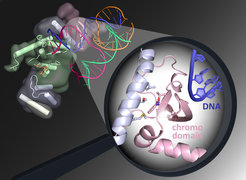The master tailor of cells

The so-called Holliday structure has nothing to do with holidays or vacation, but is rather a term that describes a complex crossover of similar DNA strings. Researcher Robin Holliday proposed this structure of genetic information in the 1960s. It occurs in DNA repair processes in our cells or during the formation of egg and sperm cells when paternal and maternal genetic information are combined. As reported by the journal eLife, scientists from the Max Planck Institute of Biochemistry in Martinsried have decoded the structure of the GEN1 protein that can undo this crossover, much like a molecular master tailor, by cutting the DNA with the highest precision in the correct place.
Our genetic information is stored in every cell of the body in a DNA double-strand molecule. These can be damaged by chemicals and ultraviolet light, which can in turn lead to breakages in the DNA strings. Many different repair mechanisms have been developed over the course of evolution to repair DNA damage and thereby ensure the survival of various organisms.
To understand the individual repair steps in the cells, Christian Biertümpfel, who leads the Molecular Mechanisms of DNA Repair Research Group, together with his team examined the molecular structure of the GEN1 protein. GEN1 plays an important role in the repair of DNA double-strand breaks. The repair involves a complex crossover of very similar DNA sections, which enables the faulty area to be repaired. The Holliday structure that emerges is then resolved again by GEN1 at the end of the repair process.
“With the aid of X-ray diffraction analysis, we were able to look at the positions of the individual amino acids, which are the basic building blocks of proteins. This allowed us to draw conclusions as to the exact structure and function of GEN1. We can now show that GEN1 works much like a molecular master tailor, inserting precisely symmetric cuts into the Holliday structure of the DNA”, explains Biertümpfel. “What is particularly notable is that GEN1 has a so-called chromodomain, which acts like a tailor’s straightedge. The chromodomain brings the DNA to be cut into the optimum position and increases the efficiency of GEN1”.
